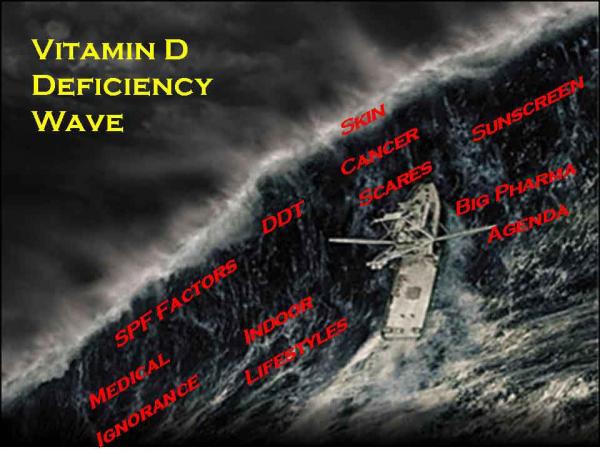Cientistas convocam para uma Ação de Saúde Pública tendo como modelo o uso do Hormônio-Vitamina D
__
CIENTISTAS CONVOCAM PARA UMA AÇÃO D*
[*PROJETO QUE TEM O PROPÓSITO DE SERVIR COMO UM MODELO DE SAÚDE PÚBLICA COM A VITAMINA D]
A DEFICIÊNCIA DE VITAMINA D É EPIDÊMICA
__
__
Sobre o assunto, assista também: Vitamina D3 – 10.000 UI diárias é vital para à saúde
40-75% of the world’s population is vitamin D deficient.
The causal link between severe vitamin D deficiency and rickets or the bone disease of osteomalacia is overwhelming, while the link between vitamin D insuffiency and osteoporosis with associated decreased muscle strength and increased risk of falls in osteoporotic humans is well documented by evidencebased intervention studies.
There are newly appreciated associations between vitamin D insufficiency and many other diseases, including tuberculosis, psoriasis, multiple sclerosis, inflammatory bowel disease, type-1 diabetes, high blood pressure, increased heart failure, myopathy, breast and other cancers which are believed to be linked to the non-calcemic actions of the parent vitamin D and its daughter steroid hormone. Based on the evidence we now have at hand, action is urgent.
It is projected that the incidence of many of these diseases could be reduced by 20%-50% or more, if the occurrence of vitamin D deficiency and insufficiency were eradicated by increasing vitamin D intakes through increased UVB exposure, fortified foods or supplements. The appropriate intake of vitamin D required to effect a significant disease reduction depends on the individual’s age, race, lifestyle, and latitude of residence. The latest Institute of Medicine (IOM) report, 2010, indicates 10,000 IU/day is considered theNOAEL (no observed adverse effect level). 4000 IU/day can be considered a safe upper intake level for adults aged 19 and older.
It is well documented that the darker the skin, the greater the probability of a vitamin D deficiency. Even in southern climates, 55% of African Americans and 22% of Caucasians are deficient.
More than 1 billion people worldwide are affected at a tremendous cost to society.
A Scientists’ Call to Action has been issued to alert the public to the importance to have vitamin D serum levels between 40 and 60 nanograms/milliliter (100-150 nanomoles/liter) to prevent these diseases. Implementing this level is safe and inexpensive.
The benefit of an adequate vitamin D level to each individual will be better overall health and a reduction in illnesses and, ultimately, a significant reduction in health care costs. The benefit of adequate vitamin D levels to society/businesses is a more productive workforce and, lower health care costs.
The D*action project has as its purpose to serve as a model for public health action on vitamin D. It is a test bed for techniques, and for providing outcome evaluation at a community level.
Related articles
- Baixos níveis do hormônio-vitamina D relacionados com dor de cabeça – Low vitamin D linked to headache(biodireitomedicina.wordpress.com)
- Seu filho recebe Vitamina D suficiente? Does your child get enough vitamin D? (biodireitomedicina.wordpress.com)
- Maior acesso a suplementos de vitamina D pode “eliminar casos de raquitismo” – Greater access to vitamin D supplements would ‘cut the cases of rickets’ (biodireitomedicina.wordpress.com)
- A verdade sobre a Vitamina D: sua carência é promovida por conflito de interesses – The Truth about Vitamin D(biodireitomedicina.wordpress.com)
- Cholecalciferol Deficiency Syndrome (sporeflections.wordpress.com)
- Vitamin D deficiencies linked to muscle injuries and alzheimer’s (sott.net)
- Vitamin D deficiency linked to asthma (foodconsumer.org)
- Catch Some Extra Rays to Prevent Heart Disease (liheart.org)
- Essential Vitamins & Minerals (coalitionofpositiveenergy.com)
- “We found a high prevalence of vitamin D deficiency in critically ill children, which was associated with higher critical illness severity,” recent study published in the journal Pediatrics (familysurvivalprotocol.com)
Avalie isto:
2 Votes
Relacionado
Vitamina D - Entrevista com Dr. Cícero Galli Coimbra sobre esclerose múltipla e demais doenças autoimunitáriasEm "A Mentira na Medicina"
Cientista brasileiro revela espantoso poder da vitamina D contra a esclerose múltipla - Globo Repórter 06.09.2013Em "A Mentira na Medicina"
Walter Feldman e o tratamento da vitamina D - O futuro - parte 4Em "A Mentira na Medicina"
Publicado em A Mentira na Medicina, A prevenção de doenças neurodegenerativas, Aborto, Administração Pública, Agrotóxicos,Alimentação e nutrição, Biodireito, Biotecnologia, Brasil, Corrupção, Direito Administrativo, Direitos do Consumidor, Doenças autoimunes, Esclerose múltipla, Facebook, Idoso, Início da vida humana, Indústria Farmacêutica, Medicina, Medicina Preventiva, Meio Ambiente, Ministério da Saúde, Ministério Público Federal, Neurologia, Notícias, Redes Sociais, Saúde Pública, Vitamina D. Tags:abortos, Blog de Celso Galli Coimbra, Brasil, Brazil, câncer, Cícero Galli Coimbra, CFM, Cientistas, Conselho Federal de Medicina,crianças, direito à vida, Direitos Fundamentais, disease, doenças autoimunes, doenças autoimunitárias, Dr. Cícero Galli Coimbra,esclerose múltipla, FENAM, gestantes, HEALTH, heart failure, Hypovitaminosis D, indústria farmacêutica, inflammatory bowel disease,Institute of Medicine, intervention studies, médicos, Medicina, Meio Ambiente, Ministério Público Federal, mulheres, nascituro,neurologia, noael, raquitismo, saúde, saúde pública, Scientists, southern climates, SUS, terapias de baixo custo, Ultraviolet, Vitamin,Vitamin D, vitamin d deficiency, Vitamina D, vitamina d3, Vitamina do Sol. 1 Comment »

30/03/2013 às 16:59